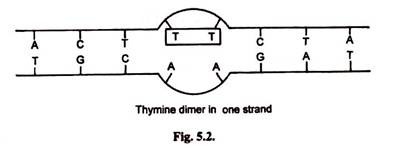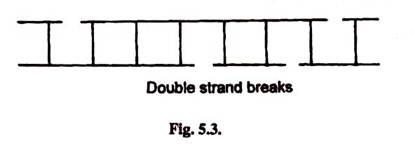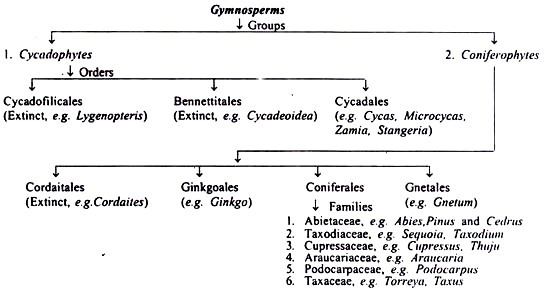Let us make an in-depth study of the DNA damage types and repair mechanisms. The damage types of DNA are: 1. Simple Mutations 2. Deamination 3. Missing Bases 4. Chemical Modification of Bases 5. Formation of Pyrimidine Dimers (Thymine Dimers) and 6. Strand Breaks. The various DNA repair mechanisms are: 1. Direct Repair 2. Excision Repair 3. Mismatch Base Repair 4. Recombination Repair or Retrieval System and 5. SOS Repair Mechanism.
Introduction to DNA Damage and Repair:
DNA is a highly stable and versatile molecule. Though sometimes the damage is caused to it, it is able to maintain the integrity of information contained in it. The perpetuation of genetic material from generation to generation depends upon keeping the rates of mutation at low level. DNA has many elaborate mechanisms to repair any damage or distortion.
The most frequent sources of damage to DNA are the inaccuracy in DNA replication and chemical changes in DNA. Malfunction of the process of replication can lead to incorporation of wrong bases, which are mismatched with the complementary strand. The damage causing chemicals break the backbone of the strand and chemically alter the bases. Alkylation, oxidation and methylation cause damage to bases. X-rays and gamma radiations cause single or double stranded breaks in DNA.
A change in the sequence of bases if replicated and passed on to the next generation becomes permanent and leads to mutation. At the same time mutations are also necessary which provide raw material for evolution. Without evolution, the new species, even human beings would not have arisen. Therefore a balance between mutation and repair is necessary.
Types of Damage:
Damage to DNA includes any deviation from the usual double helix structure.
1. Simple Mutations:
Simplest mutations are switching of one base for another base. In transition one pyrimidine is substituted by another pyramidine and purine with another purine. Trans-version involves substitution of a pyramidine by a purine and purine by a pyrimidine such as T by G or A and A by C or T. Other simple mutations are detection, insertion of a single nucleotide or a small number of nucleotides. Mutations which change a single nucleotide are called point mutations.
2. Deamination:
The common alteration of form or damage includes deamination of cytosine (C) to form uracil (u) which base pairs with adenine (A) in next replication instead of guanine (G) with which the original cytosine would have paired.
As uracil is not present in DNA, adenine base pairs with thymine (T). Therefore C-G pair is replaced by T-A in next replication cycle. Similarly, hypoxanthine results from adenine deamination.
3. Missing Bases:
Cleavage of N-glycosidic bond between purine and sugar causes loss of purine base from DNA. This is called depurination. This apurinic site becomes non-coding lesion.
4. Chemical Modification of Bases:
Chemical modification of any of the four bases of DNA leads to modified bases. Methyl groups are added to various bases. Guanine forms 7- methylguanine, 3-methylguanine. Adenine forms 3-methyladenine. Cytosine forms 5- Methylcytosine.
Replacement of amino group by a keto group converts 5-methylcytosine to thymine.
5. Formation of Pyrimidine Dimers (Thymine Dimers):
Formation of thymine dimers is very common in which a covalent bond (cyclobutyl ring) is formed between adjacent thymine bases. This leads to loss of base pairing with opposite stand. A bacteria may have thousands of dimers immediately after exposure to ultraviolet radiations.
6. Strand Breaks:
Sometimes phosphodiester bonds break in one strand of DNA helix. This is caused by various chemicals like peroxides, radiations and by enzymes like DNases. This leads to breaks in DNA backbone. Single strand breaks are more common than double strand breaks.
Sometimes X-rays, electronic beams and other radiations may cause phosphodiester bonds breaks in both strands which may not be directly opposite to each other. This leads to double strand breaks.
Some sites on DNA are more susceptible to damage. These are called hot-stops.
Repair Mechanisms:
Most kinds of damage create impediments to replication or transcription. Altered bases cause mispairing and can cause permanent alteration to DNA sequence after replication.
In order to maintain the integrity of information contained in it, the DNA has various repair mechanisms.
1. Direct Repair:
The damage is reversed by a repair enzyme which is called photoreactivation. This mechanism involves a light dependant enzyme called DNA photolyase. The enzyme is present in almost all cells from bacteria to animals. It uses energy from the absorbed light to cleave the C-C bond of cyclobutyl ring of the thymine dimers. In this way thymine dimers are monomerized.
2. Excision Repair:
It includes base excision repair and nucleotide excision repair. Base excision repair system involves an enzyme called N-glycosylase which recognizes the abnormal base and hydrolyes glycosidic bond between it and sugar.
Another enzyme, an endonuclease cleaves the DNA backbone on the 5′-side of the abnormal base. Then the DNA polymerase by its exonuclease activity removes the abnormal base. DNA polymerase then replaces it with normal base and DNA ligase seals the region.
Nucleotide repair system includes three steps, incision, excision and synthesis. Incision is done by endonuclease enzyme precisely on either side of the damaged patch of the strand. In this way damaged portion of the strand is cleaved.
Endonuclease enzymes involved are UvrA, UvrB which recognize the damaged stretch of the strand. UvrC makes two cuts (incision) on either side. Exonuclease removes the damaged strand. Enzyme involved is UvrD.
Later, DNA polymerase synthesizes the new strand by using complementary strand as a template. DNA ligase forms phosphodiester bonds which seal the ends on newly synthesized strand.
3. Mismatch Base Repair:
Sometimes wrong bases are incorporated during replication process, G-T or C-A pairs are formed. The wrong base is always incorporated in the daughter strand only. Therefore in order to distinguish the two strands for the purpose of repair, the adenine bases of the template strand are labelled or tagged by methyl groups. In this way the newly replication DNA helix is hemimethylated. The excision of wrong bases occur in the non-methylated or daughter strand.
4. Recombination Repair or Retrieval System:
In thymine dimer or other type of damage, DNA replication cannot proceed properly. A gap opposite to thymine dimer is left in the newly synthesized daughter strand. The gap is repaired by recombination mechanism or retrieval mechanism called also sister strand exchange.
During replication of DNA two identical copies are produced. Replicating DNA molecule has four strands A, B, C and D. Strands A and C have same DNA , sequence. Strands B and D also have same sequence as they are identical. A thymine dimer is present in strand A. The replication fork passes the dimmer as it cannot form hydrogen bonds with incoming adenine bases, thus creating a gap in the newly synthesized strand B.
In recombination repair system a short identical segment of DNA is retrieved from strand D and is inserted into the gap of strand B. But this creates a gap in strand D which is easily filled up by DNA polymerase using normal strand C as a template. This event is dependent on the activity of a special protein Rec A. The Rec A protein plays its role in retrieving a portion of the complementary strand from other side of the replication fork to fill the gap. Rec A is a strand exchange protein.
After filling both gaps, thymine is monomerised. So in this repair mechanism a portion of DNA strand is retrieved from the normal homologous DNA segment. This is also known as daughter strand gap repair mechanism.
5. SOS Repair Mechanism:
Sometimes the replicating machinery is unable to repair the damaged portion and bypasses the damaged site. This is known as translesion synthesis also called bypass system and is emergency repair system. This mechanism is catalyzed by a special class of DNA polymerases called Y-family of DNA polymerases which synthesized DNA directly across the damaged portion.




